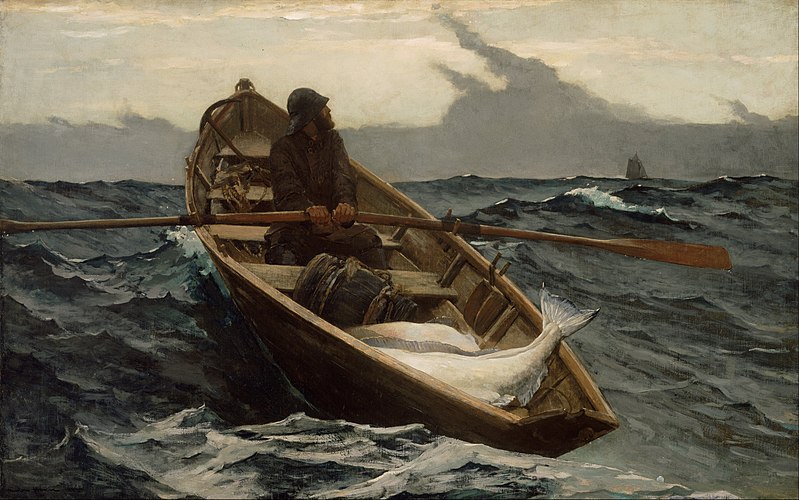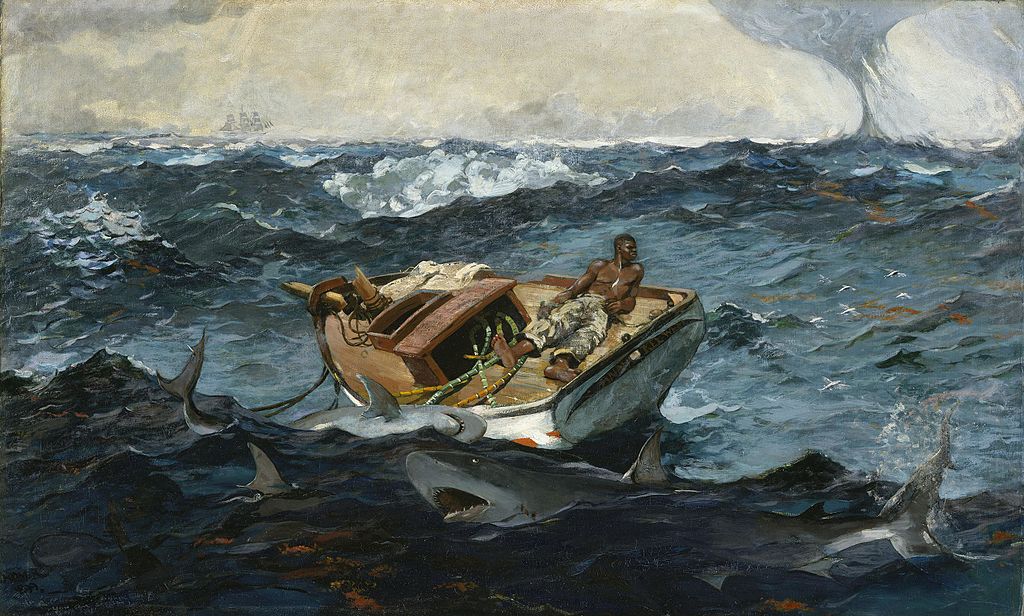AN APPRECIATION: Winslow HomerWinslow Homer was an American artist in the second half of the nineteenth century. Largely self-taught he developed his own unique style. He is best known for his depictions of the American Civil War, rural America and the sea.
Homer was born in Boston, Massachusetts on February 24, 1836. However, the family moved to nearby, still-rural Cambridge in 1842, where Winslow grew up. It was a middle-class old New England family. Winslow's father ran a hardware store. However, he abandoned the store in order to strike it rich in the California Gold Rush of 1849. When that failed to produce the desired result, the elder Homer tried a number of other get-rich-quick schemes, all of which were unsuccessful. As a result, his father was away for long periods and Winslow and his brothers were raised by their mother. Winslow showed an early interest in art but he received no formal art training while growing up. His mother, however, was a talented amateur watercolorist and she gave him lessons and encouraged his interest in art. His father also encouraged his interest in art, purchasing art supplies and reference material for his son. After Winslow graduated from high school, his father apprenticed him to a lithographer in Boston. In that job, Winslow made illustrations for popular sheet music. He hated the lack of freedom and the constraints on his creativity so much that he vowed never to work for anyone again. In 1857, Homer opened his own studio in Boston and became a freelance illustrator. Although photography had been invented, taking photographs was still a cumbersome process and it was difficult to transform them into something which could be printed. Therefore newspapers and magazines were eager to hire artists to illustrate their publications. Homer's talent was quickly recognized and he became a leading illustrator by the end of the 1850s. In 1859, Homer moved to New York City, which would be his winter home until the 1880s. When the Civil War broke out in 1861, newspapers and magazines wanted illustrations relating to the war. Harper's Weekly, the leading publication of the day, commissioned Homer to make a number of trips to the front. There, he honed his powers of observation and his ability to record essential forms. Rather than concentrate on battles and parades, Homer often drew scenes of the soldiers in camp going about their everyday lives. Back in New York, he often did illustrations showing the effect of the war on the women left behind. Homer's works were regarded as quite authentic. The people shown come across as real people. In addition, in contrast to some other contemporary illustrations, they contain detail that show they were based on actual experience. At the same time as he was working as an illustrator, Homer began to work as a painter. He took a few lessons at the National Academy of Design and from established artists such as Frederic Rondel. Quickly mastering oil painting, he exhibited paintings and received recognition from the critics. He was elected an Associate Academician of the National Academy of Design in 1864 and a full Academician in 1866. After the war, Homer continued to pursue a two-track career: working as an illustrator while at the same time, producing paintings. Although Homer is often referred to as a landscape painter, the majority of his works contain people. During this period, he often depicted rural scenes such as children playing. He also did quite a few paintings of young women engaging in athletic pursuits such as playing croquet and swimming. In sharp contrast to the horrors of the war years, Homer depicted the more pleasant side of life in America in the post-war years. In the fall of 1866, Homer traveled to France. Two of his oil paintings were going to be exhibited at the Universal Exposition of 1867. He was impressed by the landscapes of the Barbi zon school and those of Gustave Courbet. Although the Impressionists were working in Paris during this period, Homer does not appear to have had any direct contact with them despite their shared interests in direct observation, capturing light effects and in depicting modern life. Homer re-discovered watercolors in the 1870s and became quickly became a recognized master of the medium. Although he had always been able to sell his oil paintings, they did not command big prices. His watercolors gave him a new stream of income and Homer was able to give up working as an illustrator by 1875. In 1881, Homer traveled to England. He did not stay in London but settled in a fishing village on the North Sea. There, he produced watercolors of the locals and their struggle to make a living from the sea. When he returned to America, Homer shifted his base of operation from New York City to Prout's Neck, a small community on the coast of Maine where some of his family had property. The reason that Homer sought such isolation is unknown but it is frequently speculated that it was due to a romance that ended unhappily. In any event, as in England, his art continued to focus on the sea and the struggles of fishermen and seafarers. Although his cottage/studio atop a rocky cliff overlooking the sea was Homer's primary residence for the rest of his life, he traveled quite often. In the summers, he would go with his elder brother to the Adirondack mountains of New York or to the forests of Quebec in Canada. In the winters, he visited places such as Key West, Bermuda and the Bahamas. Always, he found subjects for his paintings and as he had done as an illustrator, he observed and made decisions about what to include and how much detail was needed to maintain authenticity. In 1906, Homer contracted a severe illness that kept him from working for more than a year. This was followed by a stroke in 1908. Homer died at Prout's Neck on September 29, 1910. |
Homer first achieved success with his Civil War paintings such as "Prisoners From the Front" (above). After the war, he shifted to more the pleasant aspects of life such as young women enjoying a swim in the sea. "High Tide" (below) was considered somewhat scandalous to some Victorians because of the women's "revealing" attire.
During his 1881 stay in England, Homer painted a series of pictures depicting people who made their living from the sea such as "Three Fisher Girls, Tynemouth" (above.
Homer found inspiration in the struggle of seafarers and the forces of nature as in "Fog Warning" (below). Although Homer is associated with Maine and New England, his travels took him south to the islands and into the unspoiled wilderness of North America. He found inspiration in the lives of the people who lived in those places. See, e.g. "The Gulf Stream" (above) and "The Adirondack Guide." (below).
Above: "Artists Sketching in the White Mountains."
|
Artist appreciation - Winslow Homer






